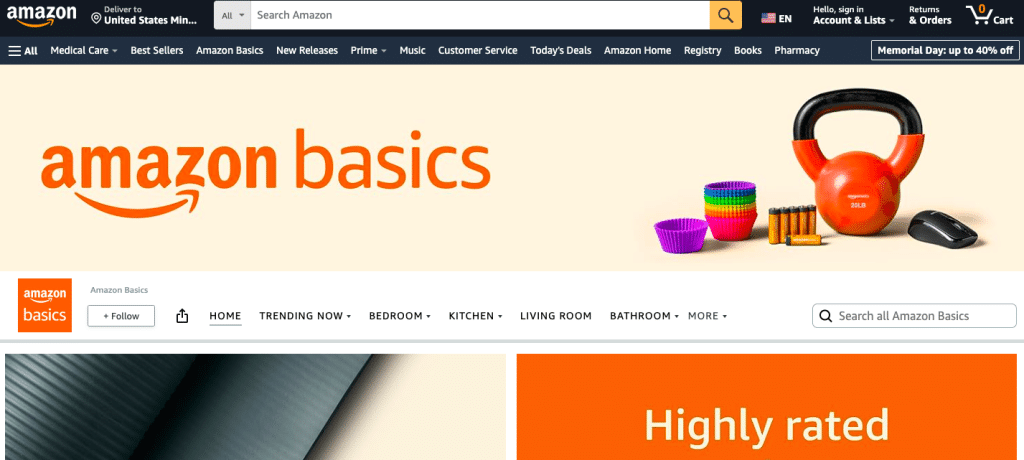Amazon Private Label is one of the most popular business models for sellers in the marketplace. Private Label allows you to create your own business and offer products online.
This approach offers more control over your sales and brand, leading to potentially higher profits. It’s a great strategy to boost your profit margins. It’s also time-consuming, however, and it’s not without risks.
But what is Private Label on Amazon? Let’s break down the pros and cons of setting up private label companies, and how to make it work in your favor.
What is Amazon Private Label?
The private label definition is quite simple: you just take an existing product, revamp it with your own brand, create your listings, and then start selling it.
Private labeling started in the early 20th century and became popular with big retailers like Walmart. Amazon then made it a well-known business model in ecommerce.
There are many private label examples, such as AmazonBasics. In this case, Amazon sources items from third-party suppliers. Amazon then sells the rebranded products for low value and high profits.
Thus, the retail giant started promoting private label products, making it easier for brands to use this model.
Benefits of Selling Private Label Products
Private labeling on Amazon offers several benefits that can significantly enhance your success. By purchasing items from private label manufacturers, and then creating your own branded products, you can differentiate yourself in a crowded marketplace.
Here’s a deeper look at the key advantages of Amazon private label.
Control over Product Quality
Amazon private label brands work directly with suppliers to design products that meet specific quality standards. This control extends to the packaging and branding, enabling you to create a unique brand identity.
Lesser Branding Restrictions
Private label requires you to enroll in Amazon Brand Registry. The program gives sellers the right to oversee their stock. But they can also control their brand. So, you won’t deal with the usual Amazon restrictions to sell in the marketplace.
Having a distinct brand can help you stand out from competitors who sell generic or unbranded items.
Increased Visibility
You’ll have the chance to create a unique image and rep, which customers will remember. Tie it up with great products, and users will come back for more.
Higher Profit Margins
Because you’re sourcing products directly from manufacturers, often at a lower cost, you can set your retail prices higher than the cost of goods sold.
Additionally, since your products are unique to your brand, you have the flexibility to set prices without being undercut by competitors. This differentiation can also justify premium pricing, especially if your brand is associated with higher quality or better customer service.
Long-Term Growth
A strong brand can foster customer loyalty and trust, leading to repeat purchases and positive word-of-mouth referrals. Over time, as your brand gains recognition, you can expand your product line, increasing your market presence and revenue streams.
This brand equity can be a valuable asset, making your business more attractive to potential buyers or investors.
New Marketing Opportunities
You’ll have the freedom to design new, more effective marketing strategies. You’ll also be able to use branding elements that resonate with your target audience.
With effective marketing, you can build a brand story that connects with customers, enhancing their emotional attachment to your products.
Reduced Competition
Your brand will be unique. So, no other seller can stand against your products. Customers will recognize you, and sellers won’t undercut your listings.
Enhanced Brand Content
Private Label stores can feature A+ Content on their Amazon listings. This means you can customize your listings with multimedia content. A+ Content is an opportunity to boost search ranks, and increase customer experience.
See also: A+ Content Guidelines
Selling Private Label on Amazon
If you want to set up a long-term Amazon store, then Private Label is the model to build upon. Let’s go over the requisites you need to start a Private Label store on Amazon.
Create an Amazon Seller Account
There are two options when setting up an Amazon account: Individual and Professional accounts.
The first option is free, but sellers are restricted to selling 40 products and they must pay a $0.99 fee per item sold. Pro accounts require a $39.99 monthly fee. You’ll also pay some referral fees, but there’s no limit to the products you can sell.
A good strategy is to start off as an individual seller. Once you build up your private label store, upgrade to a professional account.
Product Selection
Time to choose private label products to sell. Go for items with high demand but low competition. And for great results, zero in on the most profitable niche markets.Niche offers may have less visibility than well-known items. However, they make up for it with a targeted customer base and less competition.
Choose between online arbitrage or retail arbitrage, and start doing your research. Look for items with high demand and low competition. Here are some guidelines to help you out:
- Study your choices. Track your preferred items for a few weeks. Check for unique trends and consistent prices. You want to go for products that sell throughout the year.
- Go Simple and Light. Start up with small items at first, especially for individual seller accounts. This will reduce shipping times and boost manufacturing.
- Check for IP concerns. Trademark infringement claims could get your Amazon account suspended. So, make sure you acquire the rights to produce and sell.
- Set the right value. Price your items between $15-50 for a healthy revenue. Lower prices will eat your revenue, and going high may scare customers away.
Partner Up with a Supplier
Once you’ve picked some offers, find a private label manufacturing company to buy and ship from. Narrow your options to suppliers that meet the following checkmarks:
- High-quality Items. Request some samples beforehand to review the specs and quality of the products.
- Experience. Go for a supplier that permits private labeling. Also, check that it has manufactured and imported your specific products for at least 3 years.
- Rapport. Evaluate response times and feedback quality. A great seller-supplier communication will be crucial to your Amazon success.
- Capabilities. Make sure the supplier can produce items in bulks, and ship to your preferred location.
- Fair price. Your final choices should share similar price ranges. Much higher or lower prices could be a red flag.
Start your quest on sites like Alibaba. As the largest B2B platform, Alibaba features many products sold below retail value by many manufacturers.
Branding
Customize your new products with your own branding and packaging. Then, introduce your brand to the world. What makes Amazon private label unique is that it offers a lot of room to add your brand personality to your products.
Take the time to work on your brand’s details. Write and publish a compelling value proposition, and tell customers about your story. Create a unique logo and image that showcases the colors and font that best define who you are, and what you can offer.
Create an Amazon Store
This is a customized landing page to showcase your brand to consumers. Stores let you set up a unique Amazon URL. You can also share your story and value proposition through personalized content.
The goal is to engage emotionally with customers and to remain consistent. Ensure your brand is easily recognized in the packaging and on each Amazon listing.
Select Your Fulfillment Strategy
As with your Amazon account, there are two options for Shipping. The first is Amazon FBA, which allows brands to delegate logistics to Amazon. An amazon fba private label allows sellers to focus on generating revenue. Plus, FBA items are eligible for Prime delivery.
The drawback to FBA may be the storage and fulfillment fees, but there is a second option. Fulfillment By Merchant (FBM) allows brands to control all logistics. The plus side is you don’t have to deal with FBA fees, and you can add a personal touch to customer service.
FBM sellers may also enroll in Seller-Fulfilled Prime (SFP). This means you can access Prime deliveries, and still control the fulfillment process.
See also: Amazon FBM vs Amazon FBA
Listing on Amazon
Once your product is ready and you have a strong brand foundation, create a listing on Amazon. Include detailed descriptions, relevant keywords, and high-quality images, and set a competitive price.
Take Off
Now, it is time to sell. Choose one or two social media platforms based on where your audience usually hangs out. Create a content strategy you can stick to and start promoting.
You can combine both organic and paid strategies and see what works best for you. Remember that growth takes time and will not happen overnight, so start with a patient approach.
When Not to Use Amazon Private Label
Even when Amazon private label is a good option for long-term growth and brand building. That said, it’s not a fit for every seller. So, before you decide to develop your private label mastery, consider the following:
Insufficient Budget
Starting a private label company requires an upfront investment in inventory, branding, and marketing.
You must buy stock in bulk orders from a private label manufacturer. You’ll also have to start selling at low prices. This is crucial to set a solid food on Amazon until you build up your customer base.
Plus, branding is no easy task. You must be willing to invest in research and marketing campaigns to carve yourself a place amongst customers.
If you don’t have enough capital to support these costs, you may struggle to get your product off the ground.
Limited Market Knowledge
If you don’t understand the market you’re entering, private labeling on Amazon can be risky. Lack of knowledge about customer preferences, competition, and trends can lead to poor sales and wasted investment.
Unwillingness to Handle Customer Service
Amazon private label requires managing customer inquiries, returns, and complaints. If you’re not prepared to handle customer service effectively, your reputation may suffer.
Lack of knowledge of Compliance and Regulations
If you are not sure how to comply with Amazon’s policies and regulations, then you have a lot of work to do before even considering a private label.
Ignoring compliance and regulations can result in bans or product removals, so it is not a good idea to try to build a long-term strategy without understanding the rules of the game.
Inexperience with Amazon’s Algorithm
Amazon’s search algorithm is complex. Without experience in optimizing listings for SEO, managing PPC campaigns, and analyzing data, you might struggle to achieve visibility and sales.
A Few Extra Tips
Remember to check Amazon private label requirements to ensure your product meets all guidelines. And if you decide that Amazon private labeling is the way to go, you have to take advantage of it.
Do Your Market Research
Spend some time researching the market. Look for products that people are buying a lot, but that don’t have too many sellers. Use Amazon’s Best Sellers list to find popular items.
Read customer reviews to see what people like or don’t like about existing products. This will help you choose a product that customers will want..
Find a Good Supplier
Order samples first to make sure the product quality is good. Check that the supplier can meet your needs in terms of quality and delivery time. This step is crucial in setting up your private label brand.
Make Your Listings Stand Out
Use keywords that people are likely to search for. If you’re asking yourself how to sell private label on Amazon, focus on making your listings optimized for search with relevant keywords.
Build a Strong Brand
Design a logo, make your packaging look good, and tell your brand story. Your packaging should protect the product and also catch the customer’s eye. Also, spend some time making sure your packaging matches your brand’s style.
Promote
Use Amazon’s advertising tools, like Sponsored Products, to get your products noticed. Take advantage of social media, send emails to your customers, and work with micro-influencers to target specific niches.
Ask your customers for reviews and always provide great customer service to build a good reputation. Consider the differences between Amazon private label vs wholesale, or even dropshipping, to understand which approach works best for you.
Track Your Sales
Check your sales and customer feedback regularly. Use Amazon’s analytics tools to see what’s working and what’s not to improve your conversion rates. Be ready to make changes based on what you learn.
Final Thoughts
Is Amazon Private Label profitable? Yes, but it’s not easy to set up a private label store. It takes time, effort and attention. To recap, here’s how private label works in a nutshell:
- Select high-demand/low-competition items
- Buy from a product manufacturer
- Revamp the item with your own design
- Ship the rebranded products to Amazon
- Upload and optimize your listings
- Set up a marketing campaign
- Start selling
Go for niche products you can refurbish at low cost per unit. Also, establish a trustful relationship with your private label suppliers from the start. Last but not least, design a solid marketing plan to draw organic traffic and customers.
If you do it right, you’ll have the potential to attract a loyal customer base. Not only that, but you’ll generate long-term profits and become a well-known force in your industry.
Authors






